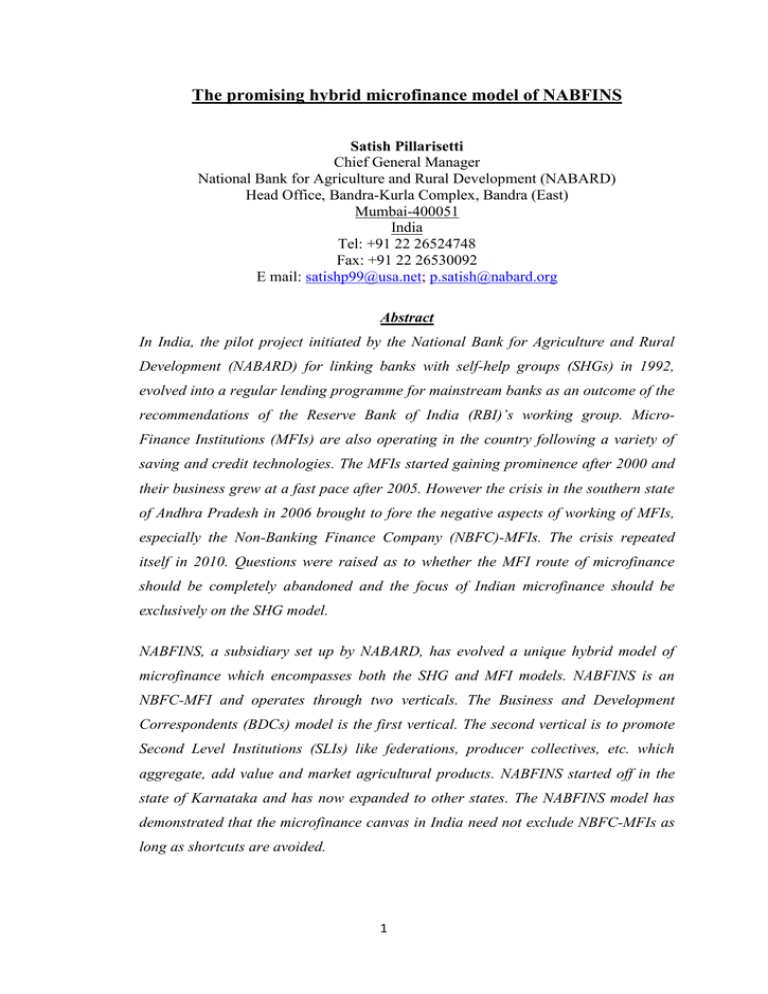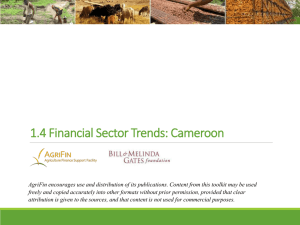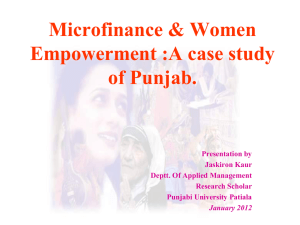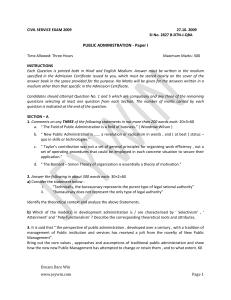File
advertisement

The promising hybrid microfinance model of NABFINS Satish Pillarisetti Chief General Manager National Bank for Agriculture and Rural Development (NABARD) Head Office, Bandra-Kurla Complex, Bandra (East) Mumbai-400051 India Tel: +91 22 26524748 Fax: +91 22 26530092 E mail: satishp99@usa.net; p.satish@nabard.org Abstract In India, the pilot project initiated by the National Bank for Agriculture and Rural Development (NABARD) for linking banks with self-help groups (SHGs) in 1992, evolved into a regular lending programme for mainstream banks as an outcome of the recommendations of the Reserve Bank of India (RBI)’s working group. MicroFinance Institutions (MFIs) are also operating in the country following a variety of saving and credit technologies. The MFIs started gaining prominence after 2000 and their business grew at a fast pace after 2005. However the crisis in the southern state of Andhra Pradesh in 2006 brought to fore the negative aspects of working of MFIs, especially the Non-Banking Finance Company (NBFC)-MFIs. The crisis repeated itself in 2010. Questions were raised as to whether the MFI route of microfinance should be completely abandoned and the focus of Indian microfinance should be exclusively on the SHG model. NABFINS, a subsidiary set up by NABARD, has evolved a unique hybrid model of microfinance which encompasses both the SHG and MFI models. NABFINS is an NBFC-MFI and operates through two verticals. The Business and Development Correspondents (BDCs) model is the first vertical. The second vertical is to promote Second Level Institutions (SLIs) like federations, producer collectives, etc. which aggregate, add value and market agricultural products. NABFINS started off in the state of Karnataka and has now expanded to other states. The NABFINS model has demonstrated that the microfinance canvas in India need not exclude NBFC-MFIs as long as shortcuts are avoided. 1 Introduction Microfinance in India has a long history embedded in the role given to the banking sector to provide small loans to the population below the poverty line. As a part of that public policy commercial banks were nationalized in 1969 and 1980 and the new entity of Regional Rural Banks were created in 1975. Banks were mandated to lend at least 40 percent of their portfolio to priority sectors, which included agriculture and allied activities, micro-enterprises, rural industries etc. In 1978 the world’s largest subsidy linked credit programme for poverty alleviation-the Integrated Rural Development Programme (IRDP) which was aimed at providing capital assets for self-employment, was launched. This programme continued till 1998 when it was merged with the group based Swarnajayanti Gram Swarojgar Yojana (SGSY-Golden Jubilee Rural Self-employment Programme). In 1974 the Self Employed Women’s Association (SEWA) of Ahmedabad started the SEWA Bank which worked on microfinance methodologies. The pilot project initiated by the National Bank for Agriculture and Rural Development (NABARD) for linking banks with self-help groups (SHGs) in 1992, evolved into a regular lending programme for mainstream banks as an outcome of the recommendations of the Reserve Bank of India (RBI)’s working group on Non-Governmental Organisations (NGOs) and SHGs. The SHG-Bank Linkage Programme has expanded at a fast pace in India to evolve into the largest microfinance programme in the world, and undoubtedly, it is the main microfinance programme in India. By the end of March 2013, 7.32 million SHGs, covering 95 million families, have been linked to banks. The outstanding credit to 4.45 million of these groups was Rs 393.75 billion (NABARD, 2013) However, there are also Micro-Finance Institutions (MFIs) operating in the country following a variety of saving and credit technologies. The MFI model in India is characterised by diversity of institutional and legal forms. There is no centralised database on the number of MFIs that operate in the country. Estimates have put it anywhere between 800 and 1200. While there are a number of NGO-MFIs and Mutual benefit MFIs (MFIs operating on cooperative principles) which operate in limited areas and on not for profit basis, it is the MFIs registered as Non-Banking Finance Companies (NBFCs) which have a larger share of the market. NBFC-MFIs 2 numbering 25 have a 60 percent share of the MFI market (loan portfolio). NonBanking Financial Companies (NBFC) are companies registered under Companies Act, 1956 and regulated by Reserve Bank of India under the Reserve Bank of India Act, 1934. The MFIs started gaining prominence after 2000 and their business grew at a fast pace after 2005. As at the end of March 2012 MFIs had a total clientele of 26.6 million with an outstanding loan business of $ 4.18 billion (Puhazhendhi, 2012). However the crisis in the southern state of Andhra Pradesh in 2006 brought to fore the negative aspects of working of MFIs, especially the NBFC-MFIs. The crisis repeated itself in 2010. Most of the NBFC-MFIs started off as NGOs and had an overall developmental objective or a social responsibility motive. Their loan portfolios grew at a slow pace, as in the case of other microfinance programmes. Later a number of these institutions transformed themselves into for profit companies as NBFCs. After their transformation into for profit NBFCs it did not take much time for these so called MFIs to jettison their social and developmental objectives and focus entirely on increasing their loan portfolios and profits. In the State of Andhra Pradesh, where the major MFIs and their businesses are located, the loan portfolio growth from 2004 to 2009 averaged between 150 and 300 percent per annum. Such a portfolio growth will not be possible if the MFI is to give sufficient attention to its collateral substitute, i.e. formation and nurturing of the group. It is an open secret that the ‘groups’ of the NBFC-MFI variant are mere collection of people sans any group characteristics, and the assemblage of these people is merely for loan disbursement and installment collection and nothing beyond that. In short these institutions transformed themselves into mere finance companies. It is a travesty of truth to call them as MFIs. Immediately after the crisis in Andhra Pradesh, the state government came out with an ordinance on regulating MFIs in the state The RBI appointed a Committee under the chairmanship of one of its directors-the Malegam Committee. The recommendations of this committee laid the new framework for guidelines for the working of NBFCMFIs. At this juncture doubts were being expressed as to the utility of MFI model of microfinance for India and whether the country should go in only for the SHG model. The NABFINS is proving to be an alternative hybrid model. 3 Genesis of NABFINS In 1996 NABARD started three NBFCs in south India to finance hi-tech agricultural projects. One of these companies was established in Bangalore. But this company failed to take off and had a nominal existence. In 2007 this company was transformed into NABARD Financial Services (NABFINS) to provide an alternative MFI platform. NABFINS is an initiative of NABARD born out of serious concerns about the practices of NBFC- MFIs. Entrusted with the responsibility of promoting MFI sector besides scaling up SHG-Bank Linkage, NABARD thought it fit to form a Micro Finance Institution with the objective of developing it as a model NBFC-MFI in the country which will facilitate setting up of bench marks and standards for the MFI sector. In particular, NABFINS objective was to ensure that the various maladies found in the NBFC-MFI sector such as lack of transparency in accounting and disclosure, high transaction cost, lack of diversification in products, increased rates of interest, coercive collection practices etc. are sought to be eliminated by establishing a fair and transparent Micro Finance Institution. NABFINS started its operations in right earnest in 2009 and predominantly gives loans to SHGs by partnering with grassroots NGOs/CBOs as Business and Development Correspondents (BDCs). NABFINS operations and reach NABFINS has its operations in 4 states i.e., Karnataka (24 districts), Tamil Nadu (20 districts), Maharashtra (5 districts) and Andhra Pradesh (4 districts) in the BDC model. It has successfully completed three full years of its operations with the total disbursements of Rs 10,825.30 million to 31,803 SHGs (as on 30.11.2013). It continues delivery of services in a transparent manner, timely and promptly at the doorstep of the clients. Table 1 is an indication of the pace of growth of NABFINS business operations and outreach. The institution which covered 31 districts in 201112 expanded to 53 districts in 2013-14. While in 2011-12 the number of SHGs covered was 6,946, it increased to 10,774 in 2013-14 representing a growth of 55 percent. The loan portfolio grew from a meagrely Rs 17.80 million in 2011-12 to Rs 3,776.1 million in 2012-13, thereafter showing a growth of 33.64 percent for the half- 4 year to Rs 5,041.62 million. As a non-deposit taking NBFC, NABFINS does not have any retail source of funds. At present it solely depends on NABARDs refinance for its lendable funds. NABARD currently lends to NABFINS at 9.9 per cent pa. In 2011-12 the institution earned a total of Rs 218.35 million of which profits before tax were Rs 35.21 million. In the next year income increased by 161.53 per cent to Rs 571.04 million and profits before tax increased by 270.78 per cent to Rs130.55 million. Table 1 Sl. No. (Amounts in Rs in millions) 2012-2013 2013 – 14 (as on 30 Nov. 13) 2011-12 Particulars 1 Loan disbursed 2,135.80 4,132.00 4,037.84 2 Cumulative loan disbursed 2,655.50 6,787.45 10,825.30 3 No. of SHGs covered 6,946 12,061 10,774 4 Cumulative no. of SHGs covered 8,969 21,029 5 No of BC units engaged 36 113 145 6 Amount disbursed to SLIs 23.00 27.16 58.43 7 Cumulative Amount disbursed to Second Level Institutions 52.51 79.67 88.93 8 Refinance NABARD 2,000.00 2,986.37 9 Loans outstanding 17.80 3,776.10 5,041.62 10 Percentage of recovery 99.9 99.9 99.9 11 Total Assets 2,749.82 5,406.66 5,583.36 31 46 53 12 Operational Cumulative (NABFINS, 2013) availed Districts from – 31,803 1,077.18 Business Models of NABFINS under the first vertical Under the first vertical NABFINS operates two models. The first one is the Business and Development Facilitators (BDF) model. The scope of activities of this model include functions that are in the nature of facilitation support services and encompass (i) identification of borrowers and fitment of activities; (ii) collection of applications 5 and verification of primary information/data; (iii) preliminary appraisal of credit, based on standard norms set by the company and using local data/information; (iv) marketing of the financial products; (v) processing and submission of applications to banks; (vi) promotion and nurturing SHGs/JLGs/Farmers Groups/Common Interest Groups etc.; (vii) post-sanction monitoring; (viii) monitoring and handholding of SHGs/ JLGs/ other Groups; and (ix) follow-up for recovery. A large variety of institutions are identified to function as BDFs. Agencies such as NGOs, Farmers Clubs, Functional Cooperatives; IT enabled rural outlets of corporate entities, postal agents, insurance agents, well-functioning Panchayats (village selfgovernment bodies) Agri Clinics/Agri Business Centers financed by banks, Krishi Vigyan Kendras (Agricultural Technology Extension Centres), Rural Multipurpose Kiosks, Village Knowledge Centres set up under private or Government initiatives can be BDFs. The facilitators are encouraged to increasingly use technological solutions and connectivity for disseminating latest product information, processing, filing of loan applications, viewing account details, etc. NABFINS is also considering engaging on contract basis, properly identified and trained youth, individuals including retired bank employees having familiarity with the local culture and language to work as facilitators. The second model under the first vertical is the Business and Development Correspondent (BDC) model. Besides the functions described for BDFs under Model A above, the BDCs provide other value added services such as (i) disbursal of credit (ii) recovery of principal / collection of interest/charges (iii) sale of micro insurance/mutual fund products/ pension products; (iv) Accepting deposits, money for remittance etc. In respect of all such transactions, the correspondents will be authorized to accept/ deliver cash either at the door step of the customers or any other convenient locations subject to the detailed agreement entered into between the company and the BDC. The BDCs are monitored closely and their performance shall be assessed periodically. Entities eligible to function as BDCs include, NGO-MFIs set up under Societies/Trust Act, Section 25 companies, Mutually Aided Cooperative Societies, Government/ 6 corporate supported IT enabled outlets, Cooperative Societies, Primary Agricultural Credit Societies (PACS), Community Managed Resource Centres, SHG Federations, Producers Collectives registered under any act or law, other registered Community Based Organizations. Before identifying any entity as BDC, a detailed due diligence on the entity is carried out by NABFINS covering critical aspects such as (i) governance, ii) well defined and transparent accounting, policies etc., (iii) availability of trained staff with knowledge of the local area and group dynamics, (iv) up-to-date accounts, (v) reasonably good management (vii) absence of any major audit observations, (viii) high degree of credibility etc. In the early stages of its operations, NABFINS initiated an experiment with a few BDCs and subsequently the number of BDCs was scaled up based on experience gained. The strategic reasons for adopting this model include: 1. Ensuring door step services. 2. Institutions with significant rural empathy will be interacting with the clients. 3. Access to the services including non-financial development services can be ensured through BDCs. 4. Other financial products which cannot be offered as an NBFC can be provided through BDCs with strategic alliance between NABFINS and other agencies at the door step. 5. The rural borrowers with low social capital will not have inhibitions in dealing with agencies working in the local area. The benefits that accrue to both NABFINS and the rural clientele include: 1. The transaction costs at both demand and supply sides can be moderated. 2. Close and field level monitoring of financial services/support and utilization can be ensured. 3. The services can be delivered at the place and time which is convenient to the client. 4. The lower transaction costs can be passed to the client through lower rates and charges. 5. Credit and enterprise counseling can be provided taking into consideration the local opportunities and potentials through the correspondents. 6. Increased outreach to even areas with poor access by engaging local, grass roots NGOs as BDFs /BDCs 7. Potential to bring convergence of various developmental activities facilitated by NGOs and meeting of credit needs required for inclusion in growth. 8. Potential to form and nurture collectives of small/marginal farmers, service providers etc. enabling them to participate in markets/growth. Second vertical of NABFINS 7 In NABFINS the first vertical of business refers to the lending to SHGs through the BDC model and the second vertical is lending to Second Level Institutions (SLI) which are mainly producer collectives, SHG federations, Co-operatives etc. which are owned by small farmers who have marketable surplus of cereals or cash crops. NABFINS has financed various institutions in States such as Kerala, Karnataka, Tamil Nadu, Andhra Pradesh and Orissa under this model. It supports the SLIs to aggregate, add value, store and market commodities. This requires various types of financing-from grants to provide professional support and for the SLI to reach viability, to term loans and risk coverage. NABFINS has been fortunate to partner with Rabo Bank and CARE which cover the risks involved in this process and draws on the support of National Commodities and Derivatives Exchange (NCDEX) for warehousing and marketing. NABFINS also trains the SHGs on group affinity, book keeping, leadership and other SHG related activities. NABFINS Values and Ethics: NABFINS started its operations with certain value premises such as: i. ii. iii. iv. v. vi. NABFINS will follow RBI and NABARD approved SHG Financing Model where loans are provided to the group and internal lending pervades through a democratic decision process. As in the case of SHG Bank Linkage Programme (SBLP), the freedom at the ultimate level would be left to the individual member and trust will be reposed on the collective wisdom of the group members to monitor the appropriate end use of the credit by the members. Peer pressure – repayment is managed by the group and any infirmity by the members will be internally managed by the peer pressure obviating the need for any coercive action from NABFINS. Keeping in tune with the fundamental objective of the Khan Committee, all services relating to: a. Demand creation, b. Assessment of credit absorption capacity, c. Grading and appraisal of groups, d. Disbursement to the group and e. Collection of repayment will be carried out at the doorstep / at a public place convenient to the groups. Focus largely on the weaker sections of the community. Adequate financial support to SHGs on the rationale that adequate and timely finance to women will result in a) Improvement in livelihood b) Improvement in health and sanitation c) Improvement in education status of children, which 8 will collectively result in incremental income and enabling the next generation to participate in growth process. NABFINS also believes that all its clients must be assured of good practices, which will be: i. Non-coercive. ii. Collection at meeting place of groups. iii. Non usurious rates. iv. Minimum gestation. v. No upfront deduction. vi. Adherence to rate, margin ceilings. vii. Adherence to Fair Practices Code in all respects. viii. No hidden charges. ix. Monthly/quarterly repayment schedule based on the need of the group x. Loan to group without security. xi. Fully transparent transactions. Interest rates A major area of criticism of MFIs in the aftermath of AP crisis is the usurious interest rates being charged by MFIs in India. MFIs on their part maintained that with the type of financial services they are offering to the clients at their doorsteps necessitates that level of interest rates to cover their operational costs. However the experience of NABFINS proves that even by providing with all types of financial services at the doorstep an institution can break even without charging exorbitant interest rates. Table 2 indicates the interest rates charged by NABFINS on various types of loan products. It may be observed therefrom that the interest rates charged by NABFINS are nearly half of those normally charged by mainstream NBFC-MFIs Table 2 Borrower Category Individuals Loan Amount Interest rate (%) Up to Rs.0.50 16.00% mln Above Rs.0.50 mln 16.75% Processing fees 1% 1% Service Tax Penal Charges 12.36% of processing fee 12.36% of processing fee SHG/JLG/ Other Up to Rs.0. 20 15.00% groups mln Loans > Rs. 0.20 16.00% 1% of sanctioned 12.36% of amount subject to a processing mln and up to ceiling of Rs. 3.0 fee Rs. 0.50 mln 9 Nil Nil Nil Institutions Loans > Rs. 0.50 16.75% lakh mln Up to Rs.2.00 15.00% 1% of sanctioned mln amount subject to >Rs. 2.00 mln 16.00% ceiling of Rs. 3.0 lakh 12.36% of processing fee Nil Interest is calculated on daily product basis (i.e., on reducing balances). Repayment of principal shall be either in equal instalments or based on cash flows (not EMI). The above measures reduce interest burden on the borrower. Case Studies The following three case studies illustrate as to how the BDC verticals and SLI verticals work out at the field level to fulfil the mandate of NABINS Case Study 1: Palmyra Palm is an important tree in Tamil Nadu. As palm leaf products are eco-friendly, several programmes have been formulated by the government with a long-term view to grow and protect these trees and to develop products using skills that help sustain rural communities. In Perumalpatti village of Melur block in Madurai district, the palm leaf workers are craftswomen from Scheduled Castes who work from home. Some of these women, with the desire to be self-employed rather than continue to work for others, formed an SHG of 13 members. To further their activities, the group decided to purchase dried palm leaves – available locally – in bulk at cheaper rates. As they stood hand in hand for bulk purchases, NABFINS granted a loan of Rs.260, 000 to the group. The SHG made good use of the loan amount and used the total amount to purchase raw materials. The members were encouraged to exhibit their products in trade fairs held at Chennai, Kanniyakumari, Delhi, Mysore by Ambedkar Hastshilp Vikas Yojana (AHVY) under the Ministry of Textiles. Their efforts were duly recognised and appreciated. The group now makes an average monthly sale of Rs.100, 000 and a net profit of around Rs.70, 000. This translates into an average net income of Rs.5, 500 per member of the group. As a result of forming the SHG and taking a productive loan from NABFINS, the group has become successful in setting up a business unit and improving their livelihoods. Their children are now able to 10 continue studies without any financial burden. Apart from economic help, successfully managing and running the SHG has helped the members improve their participation in the village’s social activities. Case Study 2: Salem District Farmers’ Club Federation (SDFCF), a collective of NABARD-promoted farmers’ clubs (FC) in Periyasorakai Village in Nangavalli block, works for the welfare of small and marginal farmers through formation of Joint Liability Groups (JLG), Common Interest Groups and Self-Help Groups (SHG) in Salem district. It promotes the practices of community-supported farming to grow vegetables and organic cotton among the small and marginal farmers. To support farmers in improving their livelihood activities, SDFCF approached Primary Agriculture Co-operative Societies (PACS) and nationalised banks for a community supported farming system, but failed to get the required support. It then approached NABFINS, which believed in the SDFCF model and provided it a financial assistance in the form of a loan of Rs.16.6 million for 40 JLGs, 5 FCs and 7 SHGs. This has been one of first farmers’ federations to become a BDC of NABFINS. The loan amount has mainly been used for purchasing milch animals and farming inputs like organic manure, bio-pesticide and seeds. This has resulted in a considerable increase in milk production – from a daily collection of 500 litres to 1,000 litres. SDFCF is now planning to install a mini milk-chilling plant, a cold storage and seed bank for their farmers. The federation realised that in order to provide maximum benefits to members, an integrated approach needs to be adapted. This idea has resulted in a project under lending window of NABARD, which would not only help the federation aggregate milk production in the area, but also provide extension services like fodder cultivation, disease management, selection of proper animal, calf rearing, artificial insemination, azolla cultivation, bio-gas, vermi-compost etc. to all beneficiaries. Case Study 3: Semmandapatti, a small village in the Omalur block of Salem district, is a hub for silk weavers – a number of families in this village are involved in silk weaving for generations. Since the weavers here are known for quality work, a number of merchants provide them with raw material and collect quality saris, paying 11 them a price for their labour. Some weavers purchase raw material on their own and sell finished products to nearby markets. Traditionally used to work with handoperated looms, the weavers are gradually shifting to power looms, which are more efficient and produce large quantities with minimal efforts. As against a handloom – which takes three days to make a sari – a power loom makes four to five saris in three days. This has reduced the drudgery of weavers and they are able to earn more and spend quality time with their families. The weavers here always had the skills to produce high quality silk saris; what they lacked, though, was an association which could act as a platform to help them work towards common interests. This need was fulfilled with the formation of Semmandapatti Silk Weavers’ Producer Association, which included weavers from Semmandapatti and nearby areas. The 140-odd members of the society belong to different economic strata – while some still work as labourers, others have either a handloom or a power loom. The Association substantially improved the collective bargaining power of the weavers and made them aware of new technology and best practices. The Association also offered loans to members from its own capital. However, the quantum of loan was never sufficient to cater to the growing needs of members. There was, thus, a serious requirement for finance to help members of the association fulfill their dreams of upward mobility. At this juncture, NABFINS entered the scene and, based on its assessment, offered a loan of Rs.4.80 million to Semmandapatti Silk Weavers’ Producer Association. With the loan amount a few members purchased handlooms, while a few others installed verb machine, buri machine and sari polishing machine as per their requirements. Not only has the financial support offered by NABFINS under its Second-Level Institutions (SLI) vertical increased the income levels of members of this weavers’ association, but it has also changed the status of many members from labourers to owners (of looms). Semmandapatti Silk Weavers’ Producer Association is eager to have their showroom in a prominent place and also want to supply raw silk to the members. In due course, they are keen to hire a designer to weave new designer saris. Needless to say that with NABFINS support, the talented silk weavers of 12 Semmandapatti have got their due, as it has helped the Weavers Association to increase their bargaining capacity. Challenges faced and the way forward In view of the economic downturn, cost of borrowing is one of the major challenges NABFINS is facing today. With dollar rates fluctuating and RBI regulating the rupee, the interest rates on lending have increased. NABFINS is in the process of identifying sources of funds at cheaper rates. The institution primarily operates on the BDC model and quality NGOs are a prerequisite for the success of this model. The lack of quality NGOs with a social inclination and rural empathy is hindering the expansion of NABFINS in new geographies. Lending to SHGs without verification of the current active loans with other organizations could lead to multiple lending. As the companies which aggregate cash flow of SHGs is limited multiple lending in turn would result in defaults of the groups. NABFINS now plans to expand to new geographies such as Chhattisgarh, Orissa, Madhya Pradesh, Goa, in the next financial year. Increasing the product portfolio to cater to the various needs of the customers is on the immediate agenda of the institution. NABFINS also aims to provide credit-plus services such as training and capacity building of SHGs and BDCs. Support to producer organizations, collectives and federations would result in minimizing risks and providing market linkages other than credit for the SHG members. Conclusion It is in the fitness of things to conclude the discussion on the hybrid model of NABFINS with a quote from the Draft 12 th Five Year Plan document. “The SHGBank Linkage programme is still the most appropriate financial mechanism to extend credit to marginal and dry land farmers as this allows better income smoothening since SHGs provide space for diversity in loan purposes and sizes, enabling financing of a variety of activities that such families select as part of livelihood strategies when income from agriculture is low. This ensures adequate credit without over indebtedness as it restores the principle of group decisions by borrowers both in borrowing process and in use of borrowed resources. This emphasis on SHG-Bank linkage need not exclude NBFC-MFIs as long as shortcuts are avoided. For example, 13 NABFINS, an NBFC promoted by NABARD, lends only to groups and uses a Business Correspondent model that also provides working capital to second level institutions such as cooperatives and producer companies which aggregate, add value and market commodities. The SHGs have a stake in these second level institutions which help expand their livelihood” (Govt. of India, 2012) Note 1. Rs is the notation of India’s currency, the Indian Rupee (INR). In 2013 the exchange value of Rupee ranged from Rs 70 to Rs 88 for 1 Euro References Govt. of India (2012), ‘Draft 12 th Five Year Plan Document’, Planning Commission, Government of India, New Delhi NABFINS (2013), ‘NABARD Financial Services Limited-Annual Report-2012-13’, Bangalore NABARD (2013), ‘Status of Microfinance in India-2012-13’, National Bank for Agriculture and Rural Development, Mumbai Puhazhendhi, V (2012), ‘Microfinance- State of the Sector Report-2012’, Sage Publications, New Delhi 14








